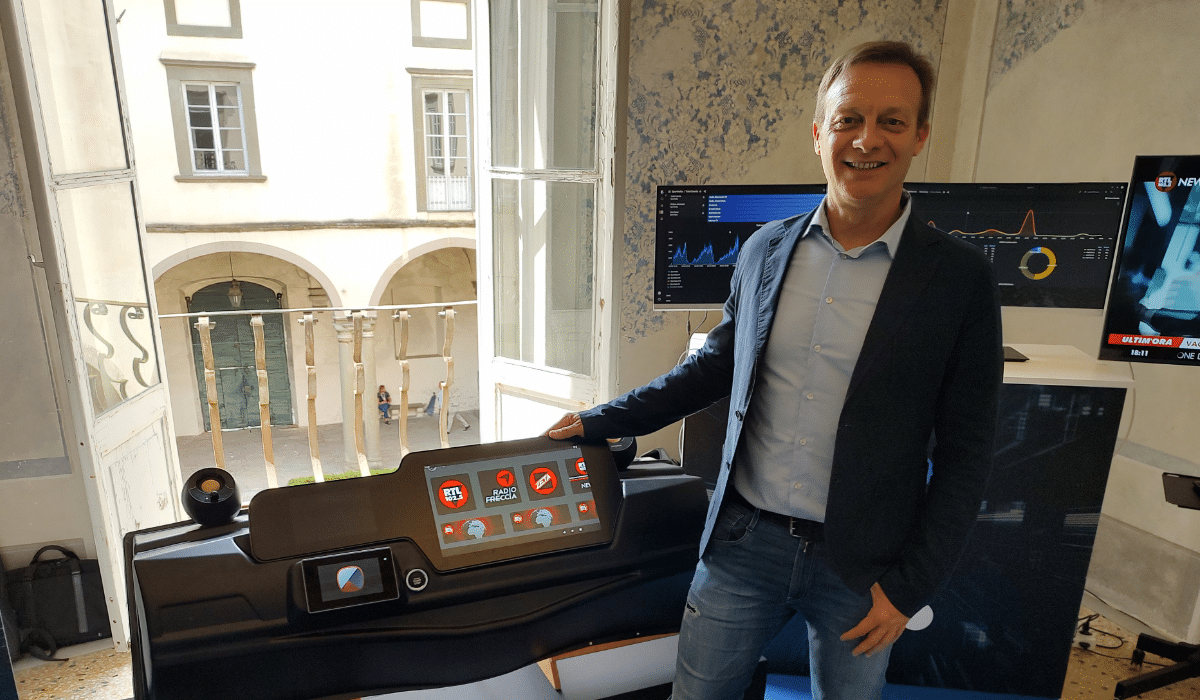LUCCA, Italy — In June, the 20th edition of the European Digital Forum, a B2B event focusing mainly on trends and developments in the video and multimedia industry, also touched base with some radio-related topics. One of those pointed to a possible future for audio in autonomous cars.
RTL 102.5 is an Italian national commercial radio broadcaster airing nine stations (six of them digital-only). In 2007, it introduced a visual radio concept — “Radiovisione” — on the founding approach “We don’t do television, we bring radio on a different platform.” One of its notable distinctions is that no speaker ever looks into the camera.
First available on free-to-air satellite and webstreaming and later also on DTT, “Radiovisione” helped boost RTL 102.5 listening figures. Since 2008 — with the single exception of 2011 — RTL 102.5 ranked first every year in the Italian market.
In the exhibition area of this year’s EDF, RTL 102.5 premiered the latest addition to their digital ecosystem: RTL 102.5 Play, which targets any digital device, including smartphones, smart TVs, smartwatches and digital assistants, through design-specific apps.
Presently, no single radio broadcaster seems to have a real chance of having its app natively installed on a new car. This is something we have to settle
Eugenio La Teana, RTL 102.5 head of innovation
“Your Alexa can wake you up in the morning by playing your favorite radio station,” says Eugenio La Teana, RTL 102.5 head of innovation. “Then you stop in the bathroom, and a second Alexa ensures a seamless audio experience. You move to the kitchen, where the same station plays, but in a richer way, through a TV screen. Then you move into your car, where radio competes with streaming platforms.”
La Teana notes the competition in entertainment for attention, which is a finite resource. Connected cars offer streaming platforms the possibility to provide their full enticing potential, so broadcasters need to consider a strategy beyond the car environment. This strategy has to center on one of radio’s strongest assets: the ability to create a seamless continuum before, during and after passengers leave the car.
To this goal, the ubiquitous availability of audio-only radio must evolve into the continuous capability to hold a listener’s attention with the specific radio content that best suits each listener’s needs, whichever the device, the place or the time of the day. Further, tuning to that particular radio content must be as easy and “familiar” as possible.
The app challenge
Connected cars usually come with some preinstalled “generic” apps, such as an audio-book reader. Larger players often have their app preinstalled into the cars’ multimedia system; Google Maps is a case in point. The same applies to global streaming platforms, like Spotify, whose apps often come as standard.
“Presently, no single radio broadcaster seems to have a real chance of having its app natively installed on a new car,” La Teana continues. “So, this is something we have to settle. Proprietary car manufacturers’ operating systems are still a hard challenge to deal with. The growing popularity of the Android Automotive OS is therefore great news.”
Android Automotive can manage the entire man-machine interface in vehicles, including the audio system and other features consumers like in their cars. RTL 102.5 developed a specific Android Automotive version of their RTL 102.5 Play application, and at this year’s EDF, delegates had an opportunity to experience the look and feel of the new app.
“We brought the whole RTL 102.5 user experience into connected cars, where the visual side of our content flows on cars’ screens, enriching passengers’ experience,” La Teana adds. “As usual, we took road safety as our top priority.” Thanks to the deep integration of Android Automotive with the car systems, the app can detect the vehicle’s speed at any time. This way, the main display visible to the driver plays the visual stream only when the vehicle speed is zero; as soon as the wheels start moving, a still image (the station’s logo, the album cover, or anything else) replaces the visual stream. However, the visual content remains playing on the car’s rear screens without any pause or interruption, allowing passengers in the rear to take full advantage of the whole RTL 102.5 experience, including purchasing event tickets, texting to on-air talent and interacting on social media.
Importantly, the car’s speed does not affect the audio content, which plays continuously. When the vehicle comes to a complete stop, the visual stream returns to the main display.
The author reports on the industry from Bergamo, Italy

